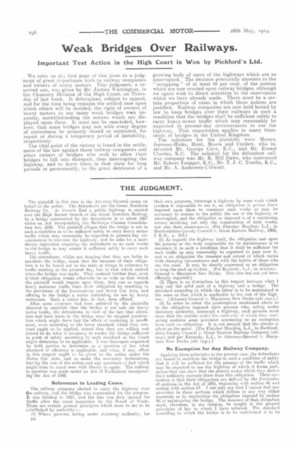Weak Bridges Over Railways.
Page 2

If you've noticed an error in this article please click here to report it so we can fix it.
Important Test Action in the High Court is Won by Pickford's Ltd.
We refer on tiic first page of this issue to a judgment of great importance both to railway companies and owners of heavy motors. This judgment, a reserved one, was given by Mr. Justice Warrington, in the Chancery Division of the High Court, on Thursday of last week. It determines, subject to appeal, and for the time being remains the settled case upon which others will be decided, the right of owners of heavy motors to use many weak bridges with impunity, notwithstanding the notices which are displayed upon them. It must not be concluded, however, that some bridges may not with every degree of correctness be properly closed or restricted, for repair or during a temporary period of instability, respectively.
The vital point of the victory is found in the settlement of the law against those railway companies and other owners of bridges who seek to allow their bridges to fall into disrepair, thus interrupting the highway, and to leave them in that state for long periods or permanently, to the great detriment of a growing body of users of the highways which are so interrupted. The decision practically amounts to the " scrapping " of at least 93 per cent, of the notices which are now erected upon railway bridges, although we again wish to direct attention to the reservation which we have already made. There must be a certain proportion of cases in which these notices are justified. Railway companies are now held bound by law to keep bridges over their railways in such a condition that the bridges shall be sufficient safely to carry heavy-motor traffic which may reasonably be expected in present-day circumstances to use the higim ay. That expectation applies to many thousands of bridges in the United Kingdom.
The solicitors for the plaintiffs were Messrs. Joynson-Hicks, Hunt, Moore and Cardew, who instructed Mr. George Cave, K.C., and Mr. Ernest Charles, K.C. The solicitor for the defendant railway company was Mr. R. Hill Dawe' who instructed Mr. Robert Younger, K.C., Mr. T. J. C. Tomlin, K.C., and Mr. A. Andrewes-Utbwatt.


























